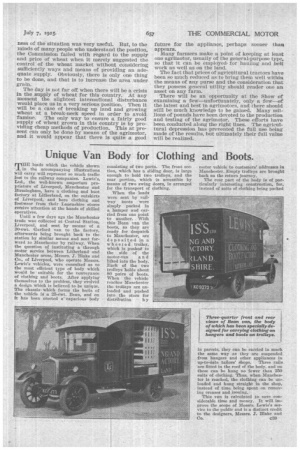Unique Van Body• for Clothing and Boots.
Page 29

If you've noticed an error in this article please click here to report it so we can fix it.
TliE loads which the vehicle shown in the accompanying illustrations will carry will represent so much traffic lOst to the railway companies. Lewis's, Ltd., the well-known emporium proprietors of Liverpool, Manchester and Birmingham, have a clothing and boot factory at Litherland, on the outskirts of Liverpool, and here clothing and footwear from their Lancashire stores receive attention at the hands of skilled operatives.
Until a few days ago the Manchester trade was collected at Central Station, Liverpool, and sent by means of a 30-ewt. Garford van to the factory, afterwards being brought back to the station by similar means and sent forward to Manchester by railway. When the question of instituting a through motor service between Litherland and Manchester arose, Messrs. J. Blake and Co., of Liverpool, who operate Messrs. Lewis's vehicles, were consulted as to the most efficient type of body which would be suitable for the conveyance of clothing and boots. After applying themselves to the problem, they evolved a design which is believed to be unique. The chassis, which forms the basis of the vehicle is a 25-cwt. Bean, and on it has been erected a' capacious body consisting of two parts. The front section, which has a sliding door, is large enough to hold two trolleys, and the rear portion, which is accessible by means of two swing doors, is arranged for the transport of clothing.
When the loads
were sent by railway boots were simply packed in a hamper and carried from one point to another. With this Bean van the boots, as they are ready for despatch to Manchester, are deposited in a wheeled trolley, which is pushed to the side of the
motor-van a it d lifted into the body. Each of the two trolleys bolds about 80 pairs of boots. When the vehicle reaches Manchester the trolleys are unloaded and pushed into the store for distribution b y motor vehicle to customers' addresses in Manchester. Empty trolleys are brought back on the return journey.
The rear part of the body is of particularly interesting construction, for, instead of suits of clothing being packed
in parcels, they can be carried in much the same way as they are suspended from hangers and other appliances in up-to-date tailors' shops. Three rails are fitted in the roof of the body. and on these can be hung no fewer than 250 suits of clothing. Thus, when Manchester is reached, the clothing can be unloaded and hung straight in the shop, instead of time being spent on removing creases and ironing.
This van is calculated to save considerable time and money. It will improve the scope of Messrs. Lewis's service to the public and is a distinct credit to the designers, Messrs. J. Blake and
Co. C39














































